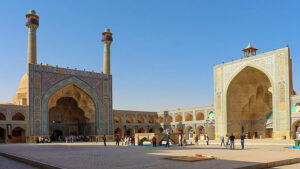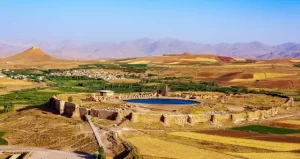
Iran is a country rich in history and culture, with a wealth of historical sites that offer tourists a glimpse of its ancient past.
Here are the top 10 historical places in Iran that are a must-visit for tourists:
1. Persepolis Iran:
2. Naqsh-e Jahan Square:
3. Golestan Palace:
4. Pasargadae:
5. Jameh Mosque of Isfahan: ‘
6. Tabriz Historic Bazaar Complex:
7. Bam and its Cultural Landscape:
8. Takht-e Soleyman:
9. Vank Cathedral:
10. Shushtar Historical Hydraulic System:
1. Persepolis Iran:

.Ancient Persepolis, which is close to Shiraz in Iran, was the Achaemenid Empire’s ceremonial capital.
This UNESCO World Heritage Site is a testament to the grandeur and sophistication of ancient Persian civilization.
Built during the reign of Darius the Great in the 6th century BCE, Persepolis is a remarkable archaeological site that showcases the architectural prowess and artistic achievements of the Persian Empire.
Visitors to Persepolis can marvel at the impressive ruins that include monumental staircases, intricately carved reliefs, and towering columns.
The Gate of All Nations, with its iconic winged bulls and cuneiform inscriptions, serves as a grand entrance to the site.
The Apadana Palace, a vast audience hall adorned with reliefs depicting delegations from various nations paying tribute to the Persian king, is a highlight of the complex.
Exploring Persepolis offers a glimpse into the political, cultural, and religious life of the ancient Persians.
The site’s well-preserved ruins provide insight into the empire’s administrative and ceremonial functions, as well as its artistic and architectural achievements.
Surrounded by the stunning landscape of the Fars Province, Persepolis offers a unique blend of history and natural beauty.
Visitors can wander through the ruins, imagining the grandeur of the ancient city that once stood there.
Tourists visiting Persepolis can immerse themselves in Iran’s heritage, connecting with its rich history and the legacy of past empires.
2. Naqsh-e Jahan Square Iran:

Naqsh Jahan Square, also known as Imam Square, is one of the most famous historical sites for tourists in Isfahan, Iran.
This UNESCO World Heritage Site is one of the largest squares in the world and is surrounded by stunning examples of Islamic architecture that date back to the Safavid era.
The square is a vibrant hub of activity, with bustling markets, traditional tea houses, and street performers adding to its lively atmosphere.
At the heart of Naqsh-e Jahan Square stands the Imam Mosque, a masterpiece of Persian Islamic architecture.
The mosque’s intricate tile work, towering minarets, and majestic dome make it a must-see for visitors.
Opposite the mosque is the Sheikh Lotfollah Mosque, known for its exquisite tile work and unique architectural design.
The Ali Qapu Palace, located on the western side of the square, offers panoramic views of Isfahan from its elevated terrace.
Visitors can explore the palace’s ornate halls, reception rooms, and music hall, which once hosted royal gatherings and ceremonies.
Surrounding the square are traditional bazaars where tourists can shop for handicrafts, carpets, spices, and souvenirs.
The Grand Bazaar of Isfahan, located on the northern side of the square, is a labyrinth of narrow alleys and bustling shops that offer a glimpse into Iran’s rich cultural heritage.
Naqsh-e Jahan Square is a historical marvel and vibrant cultural center that embodies Isfahan’s rich history and traditions.
A visit to this iconic square is a must for tourists looking to immerse themselves in the beauty and charm of Iran.
3. Golestan Palace Iran:

Golestan Palace in Tehran, Iran is one of the magnificent historical sites that showcases the grandeur of Persian architecture and design to tourists.
This UNESCO World Heritage Site is a must-visit destination for tourists seeking to immerse themselves in Iran’s rich cultural heritage.
The palace complex dates back to the Qajar era and served as the royal residence of the Qajar dynasty.
Exploring Golestan Palace allows visitors to discover beautifully adorned palaces, museums, and gardens, providing insight into Iran’s royal history.
The Mirror Hall, with its intricate mirror work and dazzling chandeliers, is a highlight of the palace and a popular spot for photos.
The Marble Throne, a magnificent structure adorned with exquisite tile work and carvings, is another must-see attraction within the complex.
The palace’s stunning gardens, filled with lush greenery, colorful flowers, and fountains, provide a peaceful retreat from the bustling city outside.
Iran’s rich cultural heritage is showcased through a diverse collection of artifacts, textiles, and artworks at the Ethnographic Museum.
Visitors can also explore the various halls and chambers that once hosted royal ceremonies, receptions, and official events.
Golestan Palace offers a unique opportunity to step back in time and experience the lavish lifestyle of Iran’s royal families.
A visit to this magnificent palace is a journey through Iran’s history, art, and architecture that will leave a lasting impression on tourists.
4. Pasargadae Iran:

Pasargadae, Iran, the initial capital of the Achaemenid Empire, is one of the significant ancient archaeological and historical sites for tourists.
This UNESCO World Heritage Site is a must-visit destination for tourists interested in exploring Iran’s rich cultural heritage.
Among the well-preserved ruins at the site is the Tomb of Cyrus the Great, founder of the Achaemenid Empire.
The tomb showcases Persian architecture with a simple yet elegant design and inscriptions honoring Cyrus’ legacy beautifully.
Exploring the Pasargadae Palace remnants allows visitors to see where Cyrus the Great resided during his reign.
The palace complex showcases courtyards, audience halls, and gardens, providing a glimpse into the grandeur of the Achaemenid Empire.
In addition to its historical significance, Pasargadae is surrounded by stunning natural beauty, with lush gardens, towering cypress trees, and picturesque landscapes that make it a peaceful and scenic destination for tourists.
The remote location of the site enhances its appeal, offering visitors a peaceful and solitary experience among ancient ruins.
Tourists visiting Pasargadae can travel back in time to the origins of the Persian Empire, immersing in its rich history.
A trip to this ancient site is a truly unforgettable experience that will leave visitors in awe of Iran’s rich and storied past.
5. Jameh Mosque of Isfahan Iran:

Dating back to the 8th century, this UNESCO World Heritage Site is among Iran’s oldest and largest mosques.
Tourists fascinated by Islamic art and architecture must visit the mosque for its intricate tile work, calligraphy, and patterns.
Exploring the Jameh Mosque of Isfahan allows visitors to see a complex of courtyards, prayer halls, minarets, and domes.
The mosque’s four-iwan design, featuring grand entrance portals and soaring domes, evokes a feeling of grandeur and spirituality for visitors.
The Jameh Mosque’s minarets provide stunning panoramic views of Isfahan’s historic city center and the surrounding mountains.
The mosque’s central courtyard, adorned with a reflecting pool and lush gardens, provides a peaceful oasis for prayer and contemplation.
Isfahan’s Jama Masjid, besides its architectural beauty, draws tourists as one of the significant historical sites in Iran for religious and cultural activities.
Visitors can learn about the mosque’s role in shaping the identity of Isfahan and its importance as a place of worship and community gathering.
Tourists exploring the Jameh Mosque of Isfahan will be amazed by centuries of Islamic art, architecture, and history.
6. Tabriz Historic Bazaar Complex Iran:

Tourists can experience the vibrant culture of the region at Iran’s Jameh Tabriz Historic Bazaar Complex marketplace.
This UNESCO World Heritage Site is one of the oldest and largest covered bazaars in the world, dating back to the 13th century.
The bazaar complex features narrow alleyways, domed chambers, and bustling shops offering spices, textiles, handicrafts, and jewelry.
Visitors to the Jameh Tabriz Historic Bazaar Complex can immerse themselves in the sights, sounds, and smells of traditional Persian market life, as they wander through the labyrinthine corridors lined with colorful stalls and bustling with local vendors and shoppers.
The Blue Mosque within the bazaar complex showcases intricate tilework and a majestic turquoise dome, highlighting Safavid architectural excellence.
Tourists can find solace in the mosque’s serene courtyard and intricate prayer hall, escaping the bazaar’s chaos.
In addition, it is one of the architectural and historical sites in Iran, the Jama Tabriz Historical Bazaar complex is a vibrant cultural center where tourists can experience the authentic sights, sounds, and tastes of Iranian daily life.
From sampling traditional Persian cuisine at local eateries to bargaining for unique souvenirs at the bustling market stalls, a visit to the bazaar complex is a sensory feast that will leave tourists with lasting memories of Iran’s vibrant cultural heritage.
7. Bam and its Cultural Landscape Iran:

Jameh Bam is a historic city located in southeastern Iran, known for its ancient citadel and cultural landscape.
The Bam Citadel, along with other architectural wonders, reflects the rich history and cultural heritage of the Achaemenid period.
Arg-e Bam, the largest adobe building globally, functioned as a strategic fortress along the ancient Silk Road.
The cultural landscape of Jameh Bam is characterized by its unique blend of traditional Persian architecture, desert environment, and historical significance.
Visitors to Jameh Bam can wander through the old city’s winding streets, admire mud-brick structures, and discover its historical significance.
In addition to its architectural wonders, Jameh Bam offers visitors a glimpse into the daily life and traditions of the local community.
From sampling traditional Iranian cuisine to shopping for handicrafts at local markets, tourists can immerse themselves in the vibrant culture of Jameh Bam and create lasting memories of their visit to this UNESCO World Heritage Site.
8. Takht-e Soleyman Iran:

Situated in Iran, Jameh Takht-e Soleyman is a captivating historical site that provides visitors with a glimpse into the past.
Travelers interested in Iran’s cultural heritage must visit this UNESCO World Heritage Site, steeped in history and mythology.
The majestic ancient Zoroastrian temple complex at the site dates back to the Sassanian era, serving as a sacred pilgrimage site.
Visitors to Jameh Takht-e Soleyman can marvel at the impressive ruins of the temple complex, which includes a grand central courtyard, a fire temple, and a sacred lake known as the “Pool of Solomon.”
The unique architecture and spiritual significance of the site offer a fascinating glimpse into ancient Iranian civilizations’ beliefs.
Tourists can enjoy the temple complex and the surrounding lush green meadows, rolling hills, and picturesque mountains.
The serene atmosphere of Jameh Takht-e Soleyman offers visitors a peaceful retreat from the hustle and bustle of modern life, allowing them to connect with nature and immerse themselves in the ancient history of the site.
Overall, Jameh Takht-e Soleyman is a must-see destination for tourists seeking to delve into Iran’s rich cultural heritage and explore the mysteries of its ancient past. Whether you’re a history buff, a nature lover, or a spiritual seeker, this remarkable site has something to offer everyone.
9. Vank Cathedral Iran:

Vank Cathedral, also known as the Holy Savior Cathedral, is a must-visit destination for tourists in Iran.
The magnificent cathedral in Isfahan showcases exquisite Armenian architecture, embodying the cultural richness of Iran’s Armenian community.
Built in the early 17th century, Vank Cathedral is renowned for its beautiful frescoes, intricate tile work, and stunning dome.
The cathedral’s exterior showcases colorful tiles depicting biblical scenes, while inside, exquisite paintings narrate the Armenian Apostolic Church’s story.
Explore Vank Cathedral’s ornate prayer halls, chapels, and bell towers filled with religious artifacts and stunning artwork.
The museum at the cathedral contains manuscripts, religious texts, and artifacts providing insight into the history of Iran’s Armenian community.
In addition to its architectural beauty, Vank Cathedral is also a place of spiritual significance for the Armenian community.
Regular religious services and events at the cathedral offer visitors a chance to immerse themselves in Armenian cultural and religious traditions.
A trip to Vank Cathedral provides an immersive look into Iran’s Armenian community’s history, art, and spirituality.
Whether you are a history buff, an art enthusiast, or a spiritual seeker, Vank Cathedral is sure to captivate and inspire you during your visit to Isfahan.
10. Shushtar Historical Hydraulic System Iran:

The Shushtar Historical Hydraulic System in Iran, a UNESCO World Heritage Site, highlights the ancient Persian engineering brilliance.
Dating back to the 5th century, this complex water management system is a testament to the advanced knowledge and skills of the people of that era.
Exploring the Shushtar Historical Hydraulic System offers a glimpse into innovative ancient water control and distribution methods.
The system includes canals, tunnels, dams, and watermills to utilize the Karun River’s power and provide water to farmlands.
Visitors have the opportunity to discover the hydraulic system’s elements, such as the remarkable Band-e Kaisar (Caesar’s Dam) from ancient times.
The ancient engineering marvel of water channels and tunnels is a must-see for history buffs and architecture enthusiasts.
Apart from being one of the historical sites of Iran, the Shushtar Historical Hydraulic System provides a peaceful and natural environment for tourists to take a leisurely stroll or have a picnic by the riverside.
The lush greenery and tranquil waters provide a welcome respite from the hustle and bustle of modern life.
Visiting the Shushtar Historical Hydraulic System offers a captivating journey into the past, showcasing Persian craftsmanship and innovation.
Don’t miss this unique opportunity to explore one of Iran’s most impressive cultural treasures.
These top 10 historical places in Iran offer a diverse range of architectural styles, cultural influences, and historical significance that make them must-visit destinations for tourists looking to explore the rich heritage of this fascinating country.







